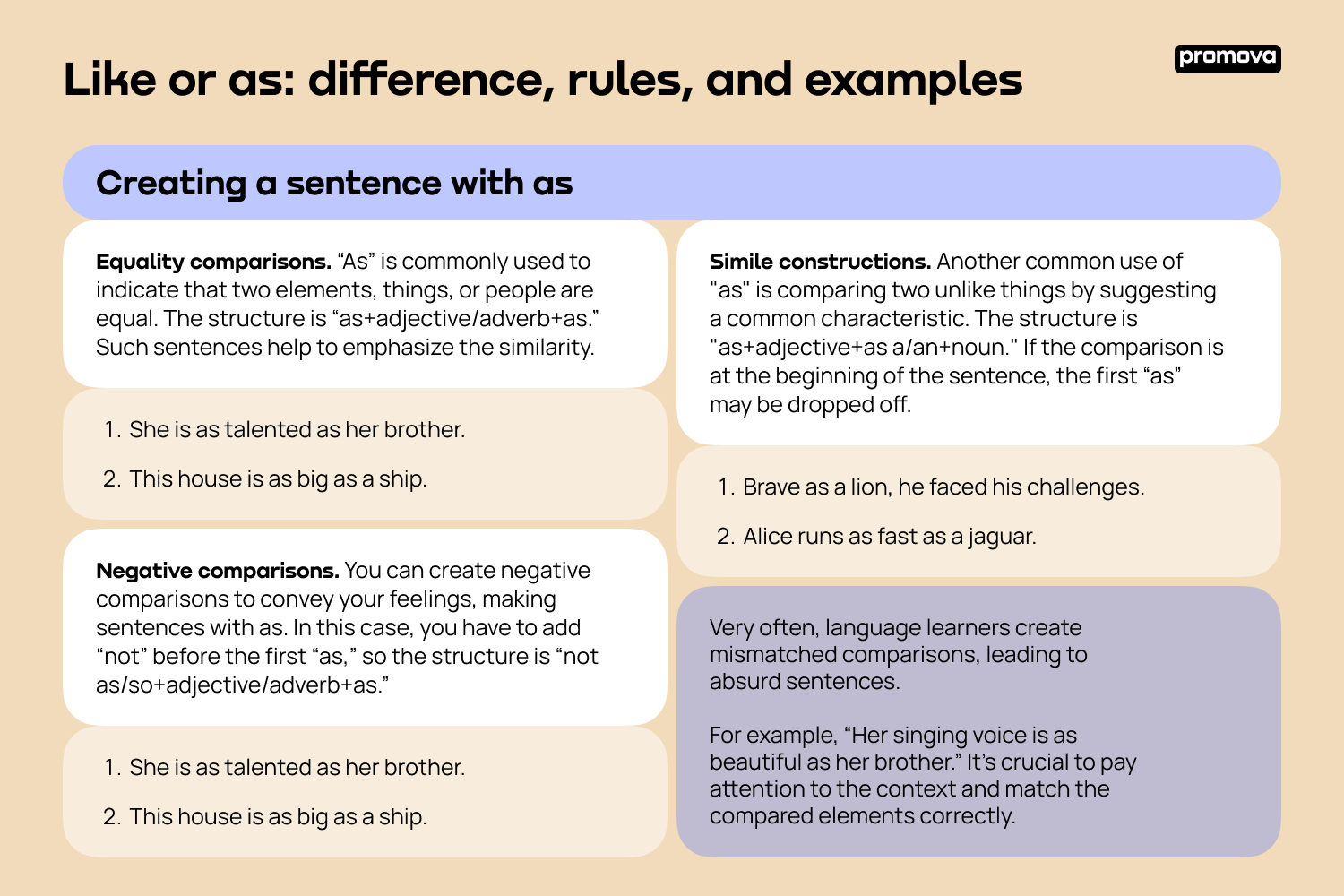Like or as: difference, rules, and examples
Contents
Comparing is an invaluable skill in communication. It helps to enrich the context, provide better understanding, and build stronger connections with people around the world. In English, you can compare things or actions using the words “as” and “like.” But they’re not always interchangeable. In this article, you will find a comparison using like or as in the English language.
Creating a sentence with as
“As” can be used in very different ways to compare things and even use comparisons as literary devices. Here are some basic rules and examples of using “as”:
- Equality comparisons. “As” is commonly used to indicate that two elements, things, or people are equal. The structure is “as+adjective/adverb+as.” Such sentences help to emphasize the similarity.
- She is as talented as her brother.
- This house is as big as a ship.
- Simile constructions. Another common use of "as" is comparing two unlike things by suggesting a common characteristic. The structure is "as+adjective+as a/an+noun." If the comparison is at the beginning of the sentence, the first “as” may be dropped off.
- Brave as a lion, he faced his challenges.
- Alice runs as fast as a jaguar.
- Negative comparisons. You can create negative comparisons to convey your feelings, making sentences with as. In this case, you have to add “not” before the first “as,” so the structure is “not as/so+adjective/adverb+as.”
- The movie was not as interesting as the original book.
- The remix was not as stunning as the original song.
Very often, language learners create mismatched comparisons, leading to absurd sentences. For example, “Her singing voice is as beautiful as her brother.” It’s crucial to pay attention to the context and match the compared elements correctly.

As if/as though
As if/as though are used for the same purpose: to make comparisons. However, sentences with these two phrases have different structures and rules. As if/as though are used for:
- Describing hypothetical situations. For example, “He acts as if he owns the place.” He doesn’t own the place, but his behavior suggests that he thinks he does.
- Compare actions or situations. For example, “The sky looked as though it was on fire at the sunset.” The sky wasn’t actually on fire, but the colors were close to the flame.
- Expressing emotions. For example, “She looked at me as if I had just spoken in an alien language.” A speaker didn’t speak an alien language, but his interlocutor reacted as if he did.
The structure of the sentences with as if/as though: “subject+verb+as if/as though+clause.” The clause usually contains a verb in a subjunctive mood, especially when referring to hypothetical situations.
3
Creating a sentence with like
When choosing between as vs like to create a comparison, you should always keep the focus on the context. “Like” is mostly used to draw parallels between people, places, and actions.
The main function of “like” is to speak about the comparison of similarity. “Like” helps to indicate similarity or equivalence in some aspects between things, places, or people. The common structure is “like+noun/pronoun.”
- She sings like an angel.
- He runs like a cheetah.
Remember not to use “like” for actions. Traditionally, "like" is not used before a clause (a subject and verb). For comparisons involving actions, "as" or "as if" is preferred.
- Correct: He runs like the wind.
- Incorrect: He sings like he's a professional. (The correct version would be "He sings as if he's a professional.")
The most common mistake is using illogical connections and trying to show the similarity. For example, one may say, “He speaks like a cheetah,” which is confusing because cheetahs don’t speak.
Conclusion
Both like and as are very important tools for indicating similarities and comparing things. When choosing between like or as, you should pay attention to context and match the elements correctly. Remember that like is appropriate only for people, places, and objects, while as is suitable for comparing actions as well. Practice comparing in writing and speaking. Very soon, you will master the rules of using these two words.
Comments